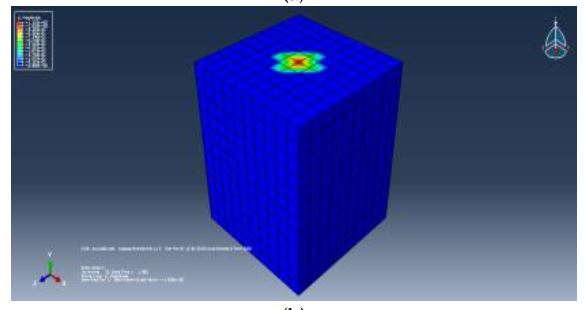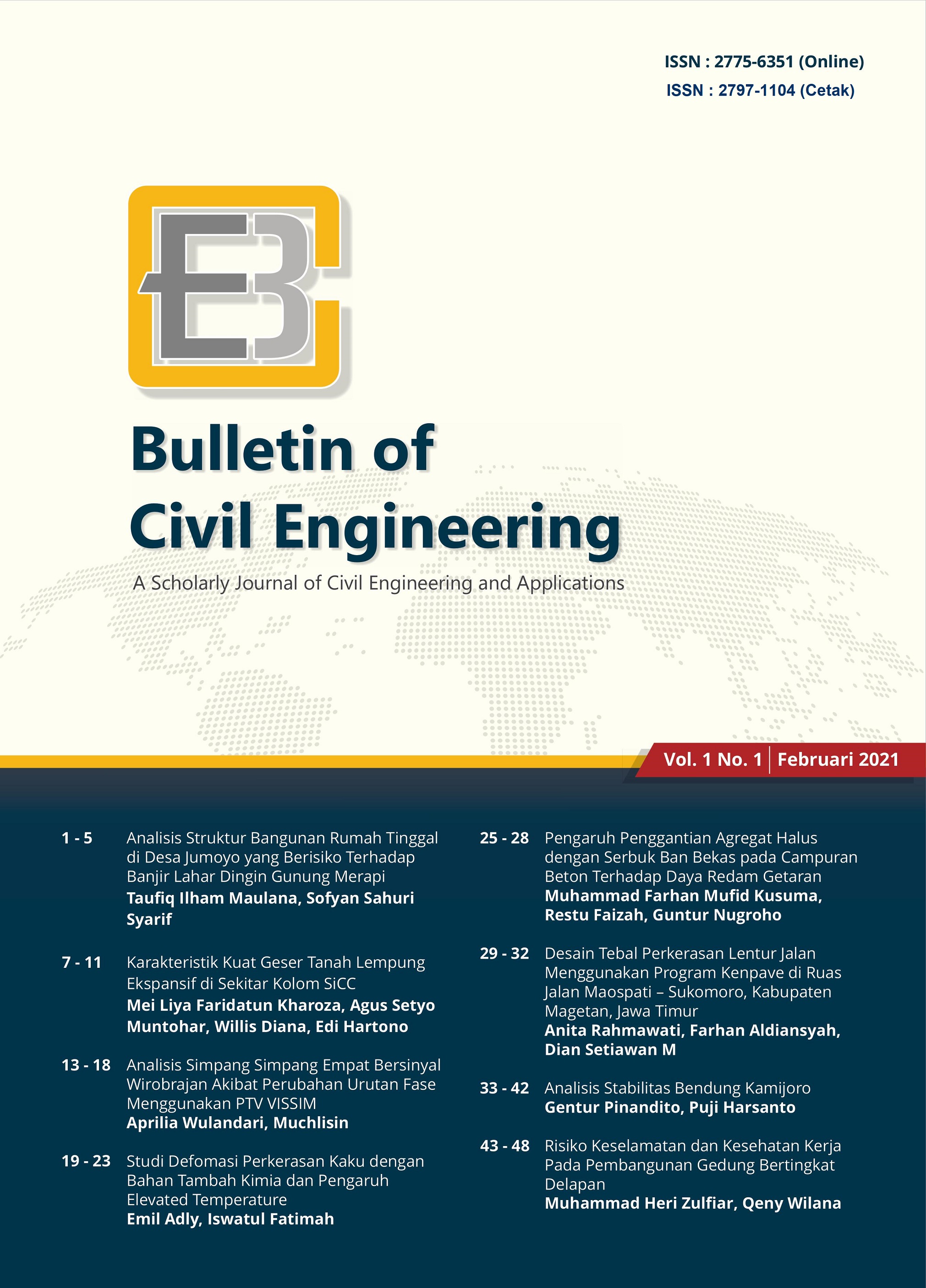Studi Defomasi Perkerasan Kaku dengan Bahan Tambah Kimia dan Pengaruh Elevated Temperature
DOI:
https://doi.org/10.18196/bce.v1i1.11059Keywords:
Abaqus, Chemical admixture, Elevated temperature, Rigid pavementAbstract
Perkerasan lentur tidak mampu menahan perubahan suhu dipermukaan selain gaya-gaya dari kendaraan yang bekerja diatasnya. Penelitian ini dilakukan untuk mengkaji karakteristik perkerasan kaku yang dibuat dari beton dengan penambahan campuran bahan kimia 0,6% Plastocrete RT06 dan 3% Sikament-NN. Hasil ujikuat tekan beton kemudian diaplikasikan pada model numerik sistem perkerasan kaku yang dianalisis dengan perangkat lunak ABAQUS untuk mengkaji pengaruh perubahan suhu terhadap deformasi lapis perkerasan kaku. Pada model numerik ketebalan masing-masing lapisan perkerasan yaitu : 30 cm lapis permukaan, 20 cm lapis pondasi bawah, dan 50 cm tanah dasar. Lapis pekerasan dimodelkan sebagai material concrete, dan lap[is fondasi serta lapis tanah dasar masing-masing dimodelkan sebagai material elastic dan keruntuhan model Drucker Prager. Hasil penelitian menunjukkan bahwa nilai kuat tekan beton berkurang 13% akibat kenaikan suhu hingga 40oC jika dibandingkan dengan beton normal. Defromasi plastis terjadi setelah pembeban melebihi 40,5 kN hingga terjadi penurunan maksimum akibat MST kendaraan sebesar 1,38 mm dan 1,48 mm masing-masing untuk beton dengan perawatan rendaman dan elevated temperature. Dengan demikian dapat dinyatakan bahwa penurunan pada lapis perkerasan kaku akibat kenaikan suhu 40oC lebih besar 7,4%.
References
Ahmad, I. A., Taufieq, N. A. S., dan Aras, A. H., 2009, Analisis Pengaruh Temperatur Terhadap Kuat Tekan Beton, Jurnal Teknik Sipil, 16 (2), 67-69.
Angjaya, N., Kurmaat, E. J., Tanudjaja, W. H., 2013, Perbandingan Kuat Tekan Antara Beton Dengan Perawatan Pada Elevated Temperature & Perawatan Dengan Perendaman Serta Tanpa Perendaman, Jurnal Sipil Statik, 1 (3),153-158.
Bastami, M., Khiabani, A., C., Baghbadrani, M., dan Kordi, M., 2011, Performance of High Strength Concrete at Elevated Temperatures, Scientia Iranica A, 18 (5),1028-1036.
Chaudhari, S. V., dan Chakrabarti, M. A., 2012, Modeling of Concrete for Nonlinier Analysis Using Finite Element Code ABAQUS, Internasional Journal of Computer Applications, 44 (7), 14-18.
Cornelis, R., Hunggurami, E., dan Tokang, N. Y., 2014, Kajian Kuat Tekan Beton Pasca Bakar Dengan dan Tanpa Perendaman Berdasarkan Variasi Mutu Beton, Jurnal Teknik Sipil, 3 (2), 161 – 172.
Kullit, V. I., Wallah, S. E., Tambato, W. J., Pandaleke, R., 2013, Pengaruh Variasi Suhu Pada Perawatan Elevated Temperature Terhadap Kuat Tekan dan Kuat Tarik Belah Beton, Jurnal Sipil Statik, 1 (7), 473-478.
Loannides, A. M., Peng, J., dan Jr., J. R. S., 2006, ABAQUS Model for PCC Slab Cracking, International Journal of Pavement Engineering, 7 (4), 311-321.
Maricar, S., Tatong, B., dan Hasan, H., 2013, Pengaruh Bahan Tambah Plastiment-VZ Terhadap Sifat Beton, Majalah Ilmiah Mektek, 15 (1), 39-50.
Mulyono, T., 2004, Teknologi Beton,Yogyakarta : Andi Offset.
Mooy, M., Simatupang, P. H., dan Frans, J. H., 2017, Pengaruh Suhu Curing Beton Terhadap Kuat Tekan Beton, Jurnal Teknik Sipil, 4 (1), 47-60.
Nawy, E. G., 1990, Beton Bertulang : Suatu Pendekatan Dasar,
Terjemahan oleh Bambang Suryoatmono, Bandung : PT Eresco.
Sutapa, A. A. G., Saputra, I. G. N. O., dan Mataram, K., 2011, Pemulihan Kekuatan Tarik Belah Beton Dengan Variasi Durasi Perawatan Pasca Bakar, Jurnal Ilmiah Teknik Sipil, 15 (2), 205-215.
Syarif, F., Adi, A. D., dan Saputra, A., 2017, Studi Karakteristik Fondasi Pelat Tipis Dengan Pengaku Tiang “+” Pada Tanah Granuler Melalui Uji Eksperimen dan Analisis Permodelan Menggunakan Software Abaqus, Jurnal Saintis, 17 (2),66-78.
Perencanaan Perkerasan Jalan Beton Semen (PD T-14-2003), Departemen Permukiman dan Prasarana Wilayah, Jakarta.
Winayati, dan Megasari, S. W., 2017, Analisis Pengaruh Penambahan Sikament-NN Terhadap Karakteristik Beton, Jurnal Teknik Sipil, 3 (2), 117-128.
Downloads
Published
Issue
Section
License
Copyright
The Authors submitting a manuscript do so on the understanding that if accepted for publication, copyright of the article shall be assigned to Bulletin of Civil Engineering (BCE). Copyright encompasses rights to reproduce and deliver the article in all form and media, including reprints, photographs, microfilms, and any other similar reproductions, as well as translations.
Authors should sign Copyright Transfer Agreement when they have approved the final proofs sent by the journal prior the publication. BCE strives to ensure that no errors occur in the articles that have been published, both data errors and statements in the article.
BCE keep the rights to articles that have been published and hold the copyright limited solely for the publication. Authors are permitted to disseminate published article by sharing the link of BCE website. Authors are allowed to use their works for any purposes deemed necessary without written permission from BCE with an acknowledgement of initial publication in this journal.
License
All articles published in BCE are licensed under a Creative Commons Attribution-ShareAlike 4.0 International (CC BY-SA) license. You are free to:
- Share — copy and redistribute the material in any medium or format
- Adapt — remix, transform, and build upon the material for any purpose, even commercially.
The licensor cannot revoke these freedoms as long as you follow the license terms. Under the following terms:
- Attribution — You must give appropriate credit, provide a link to the license, and indicate if changes were made. You may do so in any reasonable manner, but not in any way that suggests the licensor endorses you or your use.
- ShareAlike — If you remix, transform, or build upon the material, you must distribute your contributions under the same license as the original.
- No additional restrictions — You may not apply legal terms or technological measures that legally restrict others from doing anything the license permits.



